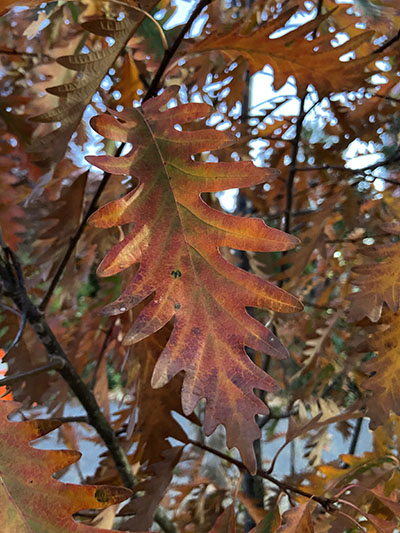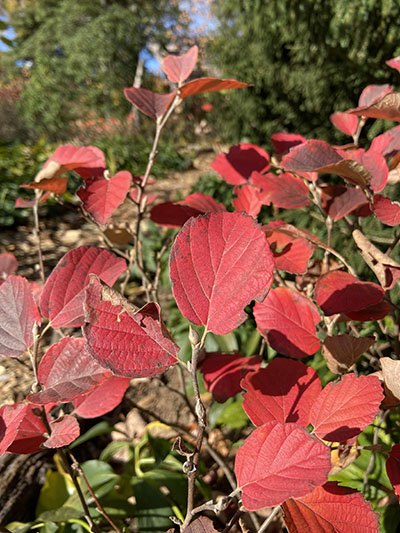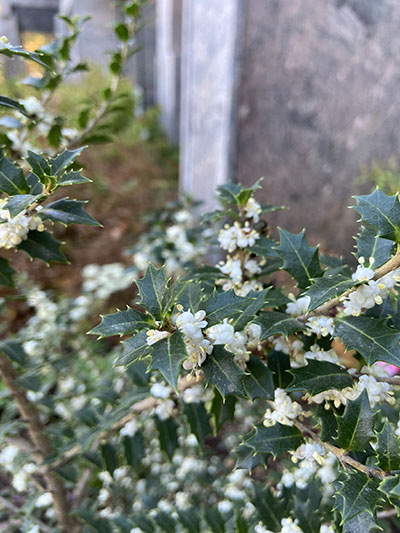
Quercus x saulii ‘Jolyn’ – Saul oak
Due to the recent time-change, my walks around the Arboretum now happen after sunset, when the light is more blue as the night encroaches on the day. And while it’s not quite as magnificent as golden-hour, this new, adjusted light has allowed me to recognize plants that I otherwise wouldn’t have. One such plant is the Quercus x saulii ‘Jolyn’ which stopped me in my tracks as I was finishing up an evening run.
A lesser known Quercus, the Saul oak is a naturally occurring hybrid between Quercus alba (white oak) and Quercus montana (chestnut oak). Oaks are classified into two groups, red or white. White oaks, like Q. alba and Q. montana are distinguished by lobed leaves with round tips, while red oaks have pointed tips. Hybridization only happens between oaks within the same group, meaning that Quercus x saulii ‘Jolyn’ is a white oak hybrid. This is easily recognizable from its rounded leaves.
The Saul oak has very evenly lobed leaves that droop downward. In the summer, they are a lovely consistent green, even with the harsh, drought-like conditions. Smooth bark varies from its Q. montana parentage, which is known for its deeply ridged bark. In the fall, the leaves are a multi-colored wonderland, with reds, browns, and purples starting at the leaf margins and moving in towards the central vein. Each fall leaf will look different from the next, with some having dark brown edges with red-orange centers and others amber edges with green centers. The Scott Arboretum has three of the ‘Jolyn’ cultivars and one straight species of the Saul oak and they can be seen and appreciated along Fieldhouse Lane near the Matchbox Fitness Center.

Fothergilla gardenia ‘Suzanne’ – dwarf fothergilla
I recently attended the inaugural “Quaker Roots Tour,” which was a collaboration between the Scott Arboretum and the Friends Historical Library (FHL). The tour was led by Arboretum staff and Jordan Landes, the curator of the FHL. It was a tour that blended horticultural knowledge with Quaker history; connecting many of the plants we have in our collections to people, places, and events pertinent to the Quaker community. One of the plants that was mentioned on the tour was the Fothergilla gardenia (dwarf fothergilla), which I learned was named by Carl Linneanus in honor of Quaker John Fothergill (1712-1780). Fotherfill was an English Quaker physician and plantsman in the 18th century who was also a patron of William Bartram.
Fothergilla gardenia is a member of the Hamamelidaceae, or witchhazel family, which contributes to its fantastic fall color. It is a slow-growing shrub that is native to moist, lowland coastal areas in the southeastern United States. Bottlebrush-like blooms appear in spring preceding leaves and the species typically has a height and spread of 2-3 feet. The cultivar ‘Suzanne’, highlighted here, was named after the youngest daughter of Dr. Michael Dirr, as in Encyclopedia of Trees and Shrubs by Michael Dirr. The cultivar offers increased tolerance of dry and shady conditions and has incredibly bright, varied fall color.

Osmanthus heterophyllus ‘Kaori Hime’ – holly tea olive
The north Kohlberg Hall Border always has something interesting going on and this week is no expectation. A small, slow-growing shrub, currently covered in hundreds of white, fragrant flowers blooming along its stems is catching everyone’s eye. Osmanthus heterophyllus ‘Kaori Hime’ blooms from October to December with flowers nestled among the miniature, dark-green, glossy, holly-esque leaves, only a half inch long. This 2009 cultivar has the name ‘Kaori Hime’, which translates to ‘fragrant princess’ in Japanese. It packs a fragrant punch, drawing in passers-by and every insect in the area. This shrub is adorable! Do yourself a favor, be like a bug and find yourself engrossed in the scent and sight of this diminutive cold-hardy cutie.
